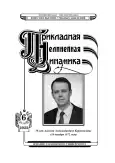Hybrid SIRS model of infection spread
- Authors: Shabunin A.V.1
-
Affiliations:
- Saratov State University
- Issue: Vol 30, No 6 (2022)
- Pages: 717-731
- Section: Articles
- URL: https://journals.rcsi.science/0869-6632/article/view/252118
- DOI: https://doi.org/10.18500/0869-6632-003014
- EDN: https://elibrary.ru/EJQVCA
- ID: 252118
Cite item
Full Text
Abstract
Keywords
About the authors
Aleksej Vladimirovich Shabunin
Saratov State Universityul. Astrakhanskaya, 83, Saratov, 410012, Russia
References
- Бейли Н. Математика в биологии и медицине. М.: Мир, 1970. 326 с.
- Марчук Г. И. Математические модели в иммунологии. Вычислительные методы и эксперименты. М.: Наука, 1991. 304 c.
- Hethcote H. W. The mathematics of infectious diseases // SIAM Review. 2000. Vol. 42, no. 4. P. 599-653. doi: 10.1137/S0036144500371907.
- Андерсон Р., Мэй Р. Инфекционные болезни человека. Динамика и контроль. М.: Мир, 2004. 784 c.
- Базыкин А. Д. Нелинейная динамика взаимодействующих популяций. Москва - Ижевск: Институт компьютерных исследований, 2003. 368 c.
- Serfling R. E. Methods for current statistical analysis of excess pneumonia-influenza deaths // Public Health Reports. 1963. Vol. 78, no. 6. P. 494-506. doi: 10.2307/4591848.
- Burkom H. S., Murphy S. P., Shmueli G. Automated time series forecasting for biosurveillance // Statistics in Medicine. 2007. Vol. 26, no. 22. P. 4202-4218. doi: 10.1002/sim.2835.
- Pelat C., Boelle P.-Y., Cowling B. J., Carrat F., Flahault A., Ansart S., Valleron A.-J. Online detection and quantification of epidemics // BMC Medical Informatics and Decision Making. 2007. Vol. 7. P. 29. doi: 10.1186/1472-6947-7-29.
- Boccara N., Cheong K. Automata network SIR models for the spread of infectious diseases in populations of moving individuals // Journal of Physics A: Mathematical and General. 1992. Vol. 25, no. 9. P. 2447-2461. doi: 10.1088/0305-4470/25/9/018.
- Sirakoulis G. C., Karafyllidis I., Thanailakis A. A cellular automaton model for the effects of population movement and vaccination on epidemic propagation // Ecological Modelling. 2000. Vol. 133, no. 3. P. 209-223. doi: 10.1016/S0304-3800(00)00294-5.
- Шабунин А. В. SIRS-модель распространения инфекций с динамическим регулированием численности популяции: Исследование методом вероятностных клеточных автоматов // Известия вузов. ПНД. 2019. T. 27, № 2. C. 5-20. doi: 10.18500/0869-6632-2019-27-2-5-20.
- Шабунин А. В. Синхронизация процессов распространения инфекций во взаимодействующих популяциях: Моделирование решетками клеточных автоматов // Известия вузов. ПНД. 2020. T. 28, № 4. С. 383-396. doi: 10.18500/0869-6632-2020-28-4-383-396.
- Фирсов О. В. Гибридное прогнозирование заболеваемости раком почки и смертности от него на основе нейросетевых и статистических технологий // Врач-аспирант. 2006. Т. 10, № 1. C. 15-32.
- Ефимова Н. В., Горнов А.Ю., Зароднюк Т. C. Опыт использования искусственных нейронных сетей при прогнозировании заболеваемости населения (на примере г. Братска) // Экология человека. 2010. № 3. C. 3-7.
- Белецкая C.Ю., Коровин В. Н., Родионов О. В. Разработка прогностических моделей развития заболеваемости детей в городском административном районе на основе нейросетевых технологий // Вестник Воронежского государственного технического университета. 2010. Т. 6, № 12. C. 201-205.
- Kermack W. O., McKendrick A. G. A contribution to the mathematical theory of epidemics // Proc. R. Soc. Lond. A. 1927. Vol. 115, no. 772. P. 700-721. doi: 10.1098/rspa.1927.0118.
- Hamer W. H. The Milroy lectures on epidemic disease in England: The evidence of variability and persistence of type // The Lancet. 1906. Vol. 1. P. 733-739.
- Hutchinson G. E. Circular casual systems in ecology // Annals of the New York Academy of Sciences. 1948. Vol. 50, no. 4. P. 221-246. doi: 10.1111/j.1749-6632.1948.tb39854.x.
- Gopalsamy K. Stability and Oscillations in Delay Differential Equations of Population Dynamics. Netherlands: Springer, 1992. 502 p. doi: 10.1007/978-94-015-7920-9.
- Пеpеваpюxа А.Ю. Непрерывная модель трех сценариев инфекционного процесса при факторах запаздывания иммунного ответа // Биофизика. 2021. Т. 66, № 2. С. 384-407. doi: 10.31857/S0006302921020204.
- Anderson R. M., May R. M. Spatial, temporal, and genetic heterogeneity in host populations and the design of immunization programmes // Mathematical Medicine and Biology: A Journal of the IMA. 1984. Vol. 1, no. 3. P. 233-266. doi: 10.1093/imammb/1.3.233.
Supplementary files










